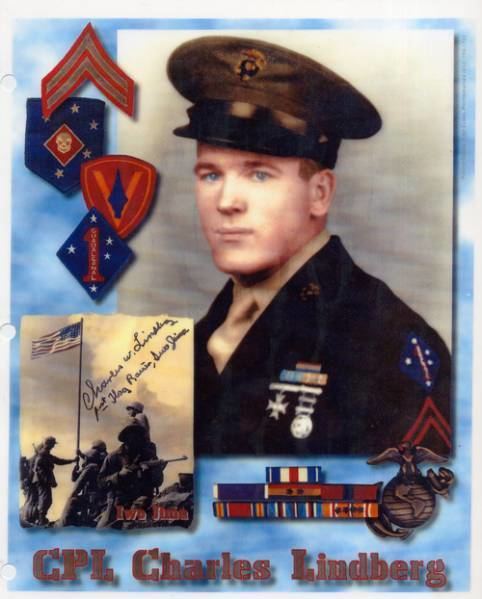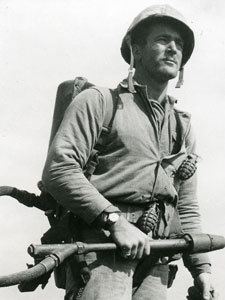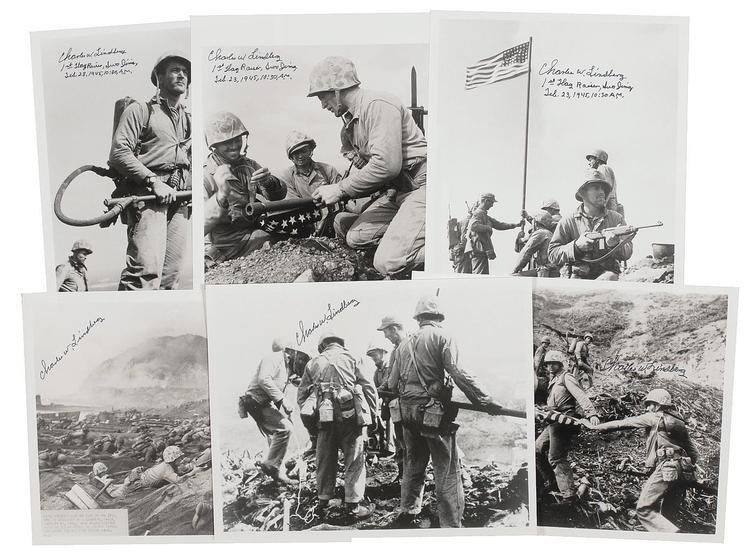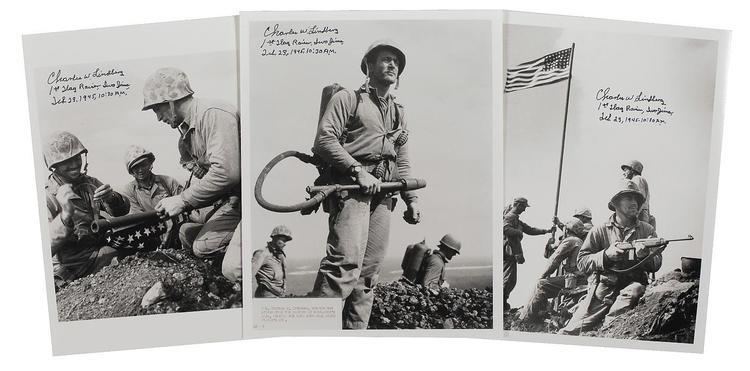Name Charles Lindberg | ||
 | ||
Battles/wars World War IIBattle of GuadalcanalBattle of BougainvilleBattle of Iwo Jima Similar People Louis R Lowery, Harold G Schrier, Henry Oliver Hansen, Raymond Jacobs | ||
Allegiance United States of America | ||
VOICES OF HISTORY PRESENTS - Cpl. Charles W. Lindberg, U.S.M.C. last surviving flag raiser Iwo Jima.
Charles W. "Chuck" Lindberg (June 26, 1920 – June 24, 2007) was a United States Marine corporal who served in World War II. He is best known for his bringing public attention to the first of two U.S. flags raised on top of Mount Suribachi on February 23, 1945, during the Battle of Iwo Jima. Lindberg was one of the last surviving members of the patrol that captured Mount Suribachi and raised the flag.
Contents
- VOICES OF HISTORY PRESENTS Cpl Charles W Lindberg USMC last surviving flag raiser Iwo Jima
- World War II
- Battle of Iwo Jima
- Post war and later life
- Marine Corps War Memorial
- Death
- Military awards
- Silver Star Medal citation
- Portrayal in films
- Public honors
- References

In 1954, the Marine Corps War Memorial in Arlington, Virginia, was modeled after the famous photograph of the second-flag raising which had been generally portrayed as the only flag-raising on Mount Suribachi. Although there was photographs taken of the first flag flying on Mount Suribachi and some which include Lindberg helping to tie the flag unto the flagstaff and standing beneath the flag after it was raised, there was no single photograph taken of Marines actually raising the first flag. The first flag was regarded to be too small and was replaced by a larger one.

World War II

Lindberg was a native of Grand Forks, North Dakota, when he enlisted in the Marine Corps shortly after the Japanese Navy attack on Pearl Harbor. Shortly after joining the Marine Corps, he volunteered for the Marine Raiders, a special Marine Corps unit. Lindberg first saw combat on Guadalcanal while serving as a member of the 2nd Raider Battalion ("Carlson's Raiders"), and participated in the "Long Patrol". He also saw combat with the 2nd Raiders on Bougainville. In February 1944, the Marine Raider and Paramarine units were disbanded and he returned to the States. He was reassigned to the newly activated 5th Marine Division at Camp Pendleton, CA. The division trained in Hawaii before leaving for Iwo Jima.
Battle of Iwo Jima

Lindberg was assigned as a flamethrower operator in 3rd Platoon, E Company, 2nd Battalion, 28th Marine Regiment, 5th Marine Division. On February 19, 1945, he landed with the fifth assault wave on the southeast beach of Iwo Jima closest to Mount Suribachi, which was the 28th Marine Regiment's objective. Because of heavy fighting, the base of Mount Suribachi was not reached and surrounded until February 22. On February 23, flamethrower operators Cpl. Lindberg and Pvt. Robert Goode of E Company were members of the 40-man combat patrol that climbed up Mount Suribachi to seize and occupy the crest and raise the Second Battalion's American flag. On March 1, Lindberg was wounded in the right forearm by a Japanese sniper and was evacuated off the island. He received the Silver Star Medal for gallantry in action from February 19 to March 1, 1945 on Iwo Jima (Pvt. Goode was also wounded on March 1 and received the Silver Star Medal).
1st Flag raising
On February 23, 1945, the Second Battalion commander ordered a platoon-sized patrol to climb up Mount Suribachi. A 40-man patrol, which was made up of Marines mostly from Third Platoon, E Company, 28th Marines, was to seize and occupy the crest of 556-foot Mount Suribachi and raise the 2nd Battalion's American flag at the summit to signal that the Mount Suribachi was captured. At 8 a.m., the patrol, led by E Company's executive officer, First Lieutenant Harold Schrier, started climbing the mountain. Less than an hour later, and after receiving occasional Japanese sniper fire, the patrol reached the rim of the volcano. After a brief firefight, Lt. Schrier and his men captured the summit.
A flag measuring 54 by 28 inches (137 by 71 cm) which had been taken from the attack transport USS Missoula (APA-211) by the Second Battalion adjutant which he carried for the battalion, was given to Schrier by the adjutant (or battalion commander) to take up the mountain and raise if he could. The flag was tied unto a long piece of a Japanese water pipe by Lt. Schrier, Sgt. Henry Hansen and Cpl. Lindberg with the help of Platoon Sergeant Ernest Thomas and Pvt. Phil Ward who held the pipe for them. The flagstaff was then carried to the highest part on the crater, and raised by Schrier, Thomas, and Hansen at approximately 10:30 a.m. Lindberg assisted the flag-raisers in planting the flagstaff firmly into the ground. As the terrific winds on Suribachi started to move the flagstaff sideways, Sgt. Hansen was assisted by Pvt. Ward and Navy corpsman John Bradley in making the flagstaff stay in a vertical position. The men at, around, and holding the flagstaff which included Schrier's radioman Raymond Jacobs (assigned to patrol from F Company), were photographed several times by Staff Sgt. Louis R. Lowery, a photographer with Leatherneck magazine who accompanied the patrol up the mountain. Seeing the national colors raised and flying caused loud cheering from the Marines, sailors, and coast guardsmen on the beach below and from the men on the ships near the beach. A firefight with some Japanese soldiers took place after the flag was raised which almost harmed Lowery after an enemy grenade exploded near him. The Second Battalion commander, Platoon Sgt. Thomas, and Sgt. Hansen were killed in action in March.
2nd flag raising
The Marines in charge of the operation to capture Iwo Jima determined about two hours or more later after the flag was raised, that another larger flag would replace the flag flying on Mount Suribachi. The 2nd Battalion's flag was considered to be too small to be seen on the other side of Mount Suribachi where the Japanese airfields and rest of the island was located (more Japanese soldiers were located there and more fighting would occur in the days ahead). While Lindberg was reloading his flamethrower tanks below Mount Suribachi, a 96 by 56 inch flag was obtained from a ship on shore and brought up to the top of Suribachi. A 4-man patrol from Second Platoon, E Company, was also sent up Suribachi with re-supplies for Third Platoon and orders to raise the replacement flag. The flag was attached to another and heavier Japanese pipe and raised (while the other flag came down) by Sgt. Michael Strank, Cpl. Harlon Block (incorrectly identified as Sgt. Hansen until January 1947), Pfc. Ira Hayes, Pfc. Franklin Sousley, Pfc. Rene Gagnon, the E Company runner who brought up the flag, and Pfc. Harold Schultz (in 2016, it was determined that corpsman Bradley did not raise the flag, and Schultz did),who was present at the first flag-raising. Lindberg included in his many public talks about the first flag-raising on Mount Suribachi, that the 2nd Battalion, 28th Marines commander, Lt. Colonel Johnson, had ordered the first flag replaced and safeguarded in order to make sure it was kept for his battalion after the battle.
Joe Rosenthal's (Associated Press) historical flag-raising photograph of the second flag-raising on Mount Suribachi appeared in Sunday newspapers on February 25, 1945, as the only flag-raising on Mount Suribachi. This flag raising was also filmed in color by Marine Sgt. Bill Genaust (killed in action in March) and was used in newsreels. Other photographers with and besides Rosenthal ascended the mountain after the first flag was raised and the mountaintop secured. These photographers including Rosenthal and an Army photographer, took photos of Marines, corpsmen, and themselves, around both of the flags. The second flag-raisers and John Bradley (instead of Howard Schultz), received national recognition for raising the flag on Iwo Jima and for the two surviving flag-raisers, Gagnon and Hayes's (and Bradley's) participation in the bond selling tour after the battle. The Marines who captured Mount Suribachi and were involved with the first flag-raising including Lindberg, generally missed out on the national recognition they were entitled to.
Post-war and later life
Lindberg was honorably discharged from the Marine Corps in 1946. He returned home to Grand Forks, North Dakota, married, moved to Richfield, Minnesota, raised two daughters and three sons, and worked as an electrician for 39 years. In the 1970s, he began telling the story publicly about the first American flag raised and flown on Mount Suribachi and his part in it (he said he raised the flag), only to have his story called into question, until more of the facts of the first flag-raising became better known and accepted by the general public. He often spoke at schools, sharing his memories of his wartime service with the children. In 1995, he returned to Iwo Jima for the 50th anniversary of the battle of Iwo Jima. In the fall of 2007, he attended his last reunion of Third Platoon, E Company, 28th Marines which was held in Washington, D.C. HELP FIX Date
Marine Corps War Memorial
The Marine Corps War Memorial (also known as the Iwo Jima Memorial) in Arlington, Virginia, which was inspired by Joe Rosenthal's photograph of the second flag-raising atop Mount Suribachi by six Marines on February 23, 1945, was dedicated on November 10, 1954 (179th anniversary of the Marine Corps). Harold Schrier and Charles Lindberg who were involved with the first-flag raising, and Lou Lowery, who took the first photographs of the first flag on Mount Suribachi, attended the dedication.
President Dwight D. Eisenhower sat upfront with Vice President Richard Nixon, Deputy Secretary of Defense Robert Anderson, and General Lemuel C. Shepherd, the 20th Commandant of the Marine Corps during the dedication ceremony. Two of the three surviving flag-raisers depicted on the monument, Ira Hayes and Rene Gagnon, were seated together with John Bradley (who was incorrectly identified as being a surviving flag-raiser) in the front rows of seats along with relatives of the second flag-raisers who were killed in action on the island. Speeches were given by Richard Nixon, Robert Anderson who dedicated the memorial, and General Shepherd who presented the memorial to the American people. Inscribed on the memorial are the following words:
In Honor And Memory Of The Men of The United States Marine Corps Who Have Given Their Lives To Their Country Since 10 November 1775Death
Lindberg died at Fairview Southdale Hospital in Edina, Minnesota, on June 24, 2007. In a tribute to Lindberg, KARE TV ran the following report:
At Fort Snelling, Friday, June 29th, 2007 the nation bid farewell to a true World War II hero. Marine Chuck Lindberg was laid to rest at Fort Snelling National Cemetery.The thundering jet fighters and some vintage WWII planes flew overhead to pay tribute. And it was well deserved.Lindberg was the last survivor of the first flag-raising on Iwo Jima's Mount Suribachi. But his moment was overshadowed by a second flag-raising. He spent a lifetime correcting the record.Still, on this Friday at Fort Snelling, there was no doubt about history's record.During the ceremony one of Lindberg's daughters, Diane Steiger said, "The angels needn't worry tonight, another Marine has arrived. Our hero has gone home, the heavens are safer tonight."Military awards
Lindberg's military decorations and awards include:
Silver Star Medal citation
For conspicuous gallantry and intrepidity while serving as Flame Thrower Operator of Company E, Second Battalion, Twenty-Eight Marines, Fifth Marine Division, in action against enemy Japanese forces on Iwo Jima, Volcano Islands, from 19 February to 1 March 1945. Repeatedly exposing himself to hostile grenades and machine-gun fire in order that he might reach and neutralize enemy pill-boxes at the bast of Mount Suribachi, Corporal Lindberg courageously approached within ten or fifteen yards of the emplacements before discharging his weapon, thereby assuring annihilation of the enemy and the successful completion of his platoon's mission. As a member of the first combat patrol to scale Mount Suribachi, he courageously carried his flame thrower to the steep slopes and assisted in destroying the occupants of the many caves found in the rim of the volcano, some of which contained as many as seventy Japanese. While engaged in an attack on hostile cave positions on March 1, he fearlessly exposed himself to accurate enemy fire and was subsequently wounded and evacuated. By his determinations in manning his weapon, despite its weight and the extreme heat developed in operation, Corporal Lindberg greatly assisted in securing his company's position. His courage and devotion to duty were in keeping with the highest traditions of the United States Naval Service.
Portrayal in films
In the film Flags of Our Fathers (2006), Lindberg is played by Alessandro Mastrobuono. Lindberg is the only character to appear in both Flags and its companion film, Letters from Iwo Jima, although in Letters he is uncredited and simply seen in the same shot of both films, rushing towards a bunker with a flamethrower.
